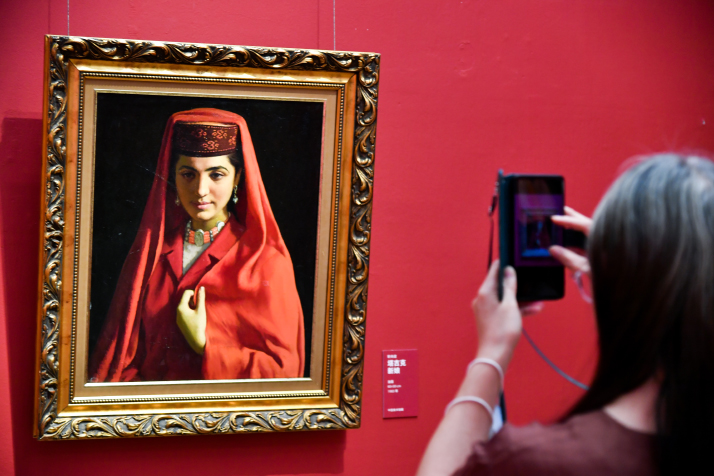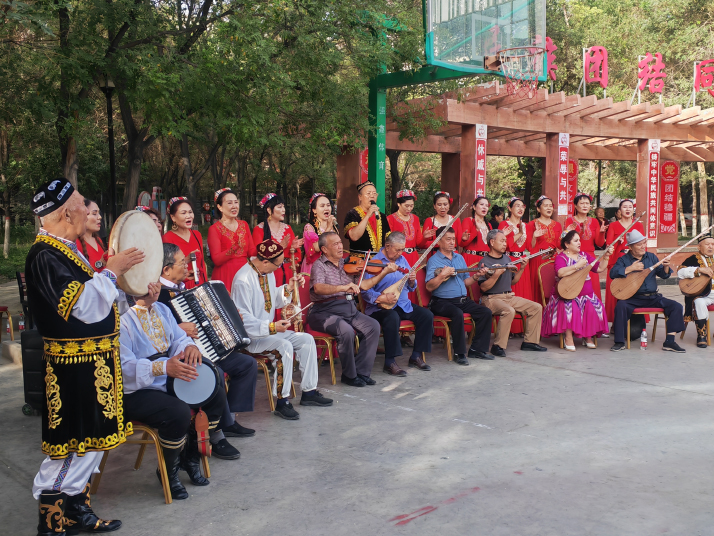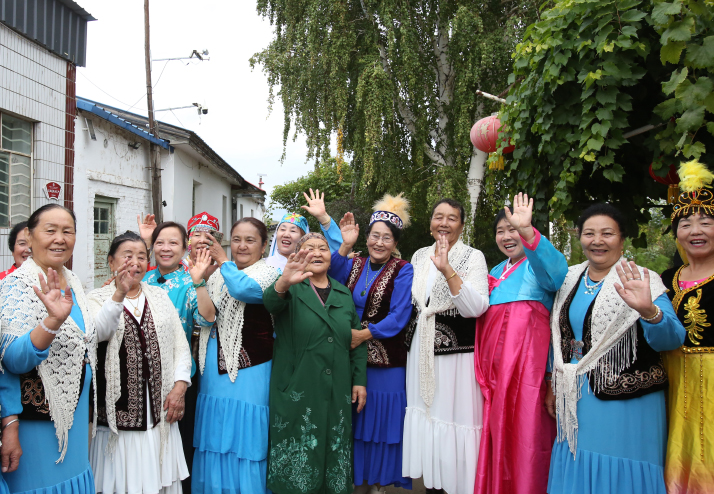| Xinjiang Today |
| Different ethnic groups help each other and stay strong together | |
|
|
 The Tajik Bride, a 1983 oil painting by eminent painter Jin Shangyi on display during a recent exhibition at the National Art Museum of China in Beijing. The painting was inspired by a wedding Jin attended in Tashikuergan (Taxkorgan or Tashkurgan) Tajik Autonomous County, Kashi Prefecture (WEI YAO)
The family of Anipa Alimahong, an 85-year-old Uygur woman, is unusual—it spans four generations and six ethnicities.
This extended family, with nearly 200 people living in Qinghe, a county in Altay Prefecture of Xinjiang, is a reminder that Xinjiang is a multiethnic region where many ethnic groups live in unity among diversity. In the early 1960s, Anipa and her husband Abibao had two children of their own. Three of her younger sisters lived with them as their parents had passed away. For this household of seven, life was not easy. Then in 1963, their neighbors, a Kazak couple, died, leaving behind three children. At a time when every family was struggling to make ends meet, Anipa, knowing well the pain of losing parents, took them in. Over the years, she adopted 10 orphans, who lived under the same roof with her nine children. Her family members are from six ethnic groups: Uygur, Kazak, Han, Hui, Tatar and Uzbek. In those years of extreme scarcity, life was very hard. The whole family lived in four mud-brick rooms, with more than a dozen children sleeping on one brick bed padded with straw and covered with felt. Their clothes were passed down from one child to another, and darned repeatedly. When Anipa's youngest daughter entered middle school, she had never had any new clothes. Keeping everyone fed was not easy. After finishing his shifts, Abibao picked up odd jobs. In spring, Anipa searched for wild vegetables; and in autumn, she gleaned the wheat and potatoes left in the fields after harvest. When her story became well-known,commanding her much respect, Anipa was asked to share it with college students. She said she had only done what anyone else would, and talked about how life had changed since. "Back then, we traveled by ox or horse cart. A trip to Urumqi used to take four days. Now it takes just four or five hours on wheels," she said. "Qinghe has also changed. The mud-brick houses are now replaced by modern apartment buildings. These are the results of good policies. We live in a moderately prosperous society now. Life keeps getting better; and whenever there's trouble, we all help one another."  The Pomegranate Seed art troupe performs in Kuerle City on September 19, 2024 (XINHUA)
The Atonghan volunteers Like Anipa, Wang Guizhen in Hutubi County of Changji Hui Autonomous Prefecture, also likes to help others. After her marriage, Wang, a Han, lived in a multiethnic neighborhood. Her neighbor Niyazihan, a single Uygur mother with paralysis, struggled to raise her seven children. Seeing her hardship, Wang asked for permission to tear down the wall between their courtyards so it was more convenient to cook for her, do her laundry and help keep her home in order. Wang did this for eight years. "You truly have an atonghan (a heart of gold in the Uygur language)," Niyazhan thanked Wang, with tears in her eyes before passing away. In 2012, Wang set up the Atonghan volunteer service team. At first, it was just a handful of warmhearted neighbors. But as people heard her story, more and more were inspired to join. Today, the Atonghan volunteer network has grown into an association with over 26,000 members and more than 180 service teams, active year-round in both towns and villages. Han, Uygur, Kazak, Hui and other volunteers provide service ranging from elder care and child support to poverty relief and assistance for those with disability. Each morning, despite her advanced age, Wang still stops by the community volunteer office to see which families need help or whether supplies are running low. "Our strength comes from our unity. Every ethnic group is part of one big Chinese family. Only by helping one another can we truly be one family," she often reminds her team. Hainisha Muhan is one of the volunteers. Once she was helped by Wang and is now giving it back by joining the team. "I learned from working with Wang Guizhen that all ethnic groups must care for and support each other. Only when we are united can life get better for everyone," she said. In 2018, Wang's story was made into a film, titled Atonghan, a powerful tribute to ethnic unity.  Residents of Hongdun Town in Altay Prefecture pose for a photo on September 9. Hongdun is home to 11 ethnic groups, with the ethnic minorities making up 51 percent of the town's population (XINHUA)
Sense of community Xinjiang has been a multiethnic region since ancient times. In Tacheng Prefecture, located in northwest Xinjiang, members of 29 ethnic groups live there, including Han, Uygur, Kazak and Russian. In the Haldun community of Tacheng, more than 3,800 residents live in 1,510 households. They are from 14 ethnic groups, with ethnic minorities accounting for 66.69 percent of the population, according to official statistics. "Our family is a big household that has members from several ethnic groups. When it comes to festivals, children and relatives come from different places, and everyone shows their strengths by making a full table of traditional dishes, which is especially grand," resident Bai Zhijun told China Daily. In Haldun, multiethnic families are not uncommon, with about one third of the families composed of two or more ethnic groups. Families often help each other. Halidan Yilahong, a resident of the community told China Central Television (CCTV), "When I'm painting walls or making desserts, my neighbors often come to help. If anything unusual happens at their house, I'll go to help them. It's always been this way." In this community, relatives, friends and neighbors get together from time to time, sharing dumplings and bread, and playing the violin and the accordion together, making life colorful and vibrant. "In Tacheng, people don't differentiate between ethnicities. We love each other, help each other, support each other, and live together in harmony and happiness," Mukashi Saimaiti, a resident in the community, told CCTV. "We are like pomegranate seeds, tightly embracing each other in one big family," Shanam Shardar, another resident of the community added. (Print Edition Title: Heart of Gold) Comments to lanxinzhen@cicgamericas.com |
|
||||||||||||||||||||||||||||
|